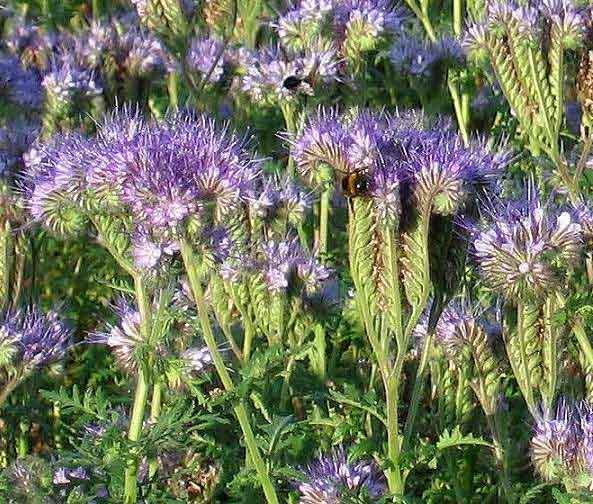
Phacelia tanacetifolia (*)
Classification System: APG IV
Superregnum: Eukaryota
Regnum: Plantae
Cladus: Angiosperms
Cladus: Eudicots
Cladus: Core eudicots
Cladus: Asterids
Cladus: Lamiids
Ordo: Boraginales
Familia: Boraginaceae
Subfamilia: Hydrophylloideae
Genus: Phacelia
Species: Phacelia tanacetifolia
Name
Phacelia tanacetifolia Benth., 1835
Synonyms
Phacelia commixta Greene
Phacelia tanacetifolia var. cinerea Brand
Phacelia tanacetifolia var. genuina Brand
Phacelia tanacetifolia var. pseudodistans Brand
Phacelia tanacetifolia f. staminea Brand
Phacelia tanacetifolia var. tenuifolia Torr.
Phacelia tanacetifolia subvar. tenuisecta Brand
Phacelia tripinnata Fisch., C.A.Mey. & Avé-Lall.
Distribution
Native distribution areas:
Continental: Northern America
Regional: Southwestern USA
California, Mexico Northwest
Introduced into:
Algeria, Altay, Amur, Austria, Baltic States, Belarus, Belgium, Bulgaria, Buryatiya, Canary Is., Central European Russia, Cyprus, Czechoslovakia, Denmark, East Aegean Is., East European Russia, France, Great Britain, Hungary, Irkutsk, Italy, Kazakhstan, Kirgizstan, Krasnoyarsk, Morocco, Netherlands, Northwest European Russia, Norway, Poland, Portugal, Primorye, Romania, South European Russia, Sweden, Switzerland, Tadzhikistan, Ukraine, Uzbekistan, West Siberia, Yugoslavia
References: Brummitt, R.K. 2001. TDWG – World Geographical Scheme for Recording Plant Distributions, 2nd Edition
References
Primary references
Bentham, G., 1835. Transactions of the Linnean Society of London 17: 280
Links
Govaerts, R. et al. 2020. Phacelia tanacetifolia in Kew Science Plants of the World online. The Board of Trustees of the Royal Botanic Gardens, Kew. Published online. Accessed: 2020 Oct 23. Reference page.
International Plant Names Index. 2020. Phacelia tanacetifolia. Published online. Accessed: Oct 23 2020.
Tropicos.org 2020. Phacelia tanacetifolia. Missouri Botanical Garden. Published online. Accessed: 23 Oct 2020.
Catalogue of Life: 2021 Annual Checklist
USDA, ARS, Germplasm Resources Information Network. Phacelia tanacetifolia in the Germplasm Resources Information Network (GRIN), U.S. Department of Agriculture Agricultural Research Service. Accessed: November 11, 2017.
Vernacular names
čeština: svazenka vratičolistá
English: Lacy Phacelia
suomi: Aitohunajakukka
français: Phacélie à feuilles de tanaisie
Nederlands: Phacelia
slovenčina: facélia vratičolistá
Türkçe: Arı otu
Phacelia tanacetifolia is a species of flowering plant in the borage family Boraginaceae, known by the common names lacy phacelia, blue tansy or purple tansy.
Etymology
Phacelia is derived from Greek and means 'bundle', in reference to the clustered flowers, while tanacetifolia means 'with leaves resembling those of Tanacetum.'[1]
Description
Phacelia tanacetifolia is an annual that grows erect to a maximum height near 100 cm (40 in) with none to a few branches. The wild form is glandular and coated in short stiff hairs. The leaves, 20–200 mm (1–8 in), are mostly divided into smaller leaflets which are deeply and intricately cut into toothed lobes, giving them a lacy appearance. The dense and hairy inflorescence is a one-sided curving or coiling cyme of bell-shaped flowers in shades of blue and lavender. Each flower is just under a centimeter long and has protruding whiskery stamens.[2]
The seeds are "negatively photoblastic", or photodormant, and will only germinate in darkness.[3]
Range and uses
Beneficial insects
Phacelia tanacetifolia is native to the Southwestern United States and northwestern Mexico. It is most common in the deserts of southern California at elevations below 1,500 m (5,000 ft), but may be occasionally found at much higher elevations. [4][5]
It is used outside its native range in agriculture as a cover crop, a bee plant, an attractant for other beneficial insects, as a green manure[6] and an ornamental plant. It is planted in vineyards and alongside crop fields, where it is valued for its long, coiling inflorescences of nectar-rich flowers which open in sequence, giving a long flowering period.[7] It is a good insectary plant, attracting pollinators such as bumblebees and honey bees.[7]
Biological pest control
It is also attractive to hoverflies (family Syrphidae), which are useful as biological pest control agents because they eat aphids and other pests.[8]
Seeds
References
Gledhill, David (2008). "The Names of Plants". Cambridge University Press. ISBN 9780521866453 (hardback), ISBN 9780521685535 (paperback). pp 229, 370
"Phacelia tanacetifolia". in Jepson Flora Project (eds.) Jepson eFlora. Jepson Herbarium; University of California, Berkeley. 2018. Retrieved 2018-07-06.
Serrato-Valenti, S., et al. (1998). A histological and structural study of Phacelia tanacetifolia endosperm in developing, mature, and germinating seed. International Journal of Plant Sciences 159:5 753-61.
Sullivan, Steven. K. (2018). "Phacelia tanacetifolia". Wildflower Search. Retrieved 2018-07-06.
"Phacelia tanacetifolia". Germplasm Resources Information Network (GRIN). Agricultural Research Service (ARS), United States Department of Agriculture (USDA). Retrieved 12 January 2018.
"Green Manure". RHS. Retrieved 15 October 2015.
Phacelia tanacetifolia: A brief overview of a potentially useful insectary plant and cover crop. Small Farm Fact Sheet.
Hickman, J. M. & W. D. Wratten. (1996). Use of Phacelia tanacetifolia strips to enhance biological control of aphids by hoverfly larvae in cereal fields. Journal of Economic Entomology 89:4 832-40.
Retrieved from "http://en.wikipedia.org/"
All text is available under the terms of the GNU Free Documentation License

